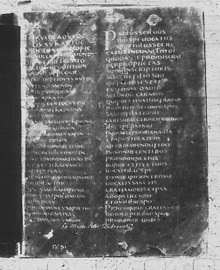Top Qs
Timeline
Chat
Perspective
Codex Sangermanensis
New Testament manuscript From Wikipedia, the free encyclopedia
Remove ads
Codex Sangermanensis designated by Dabs1 or 0319 (in the numbering Gregory-Aland), α 1027 (Soden), is a tenth-century diglot manuscript, formerly in the library of St. Germain des Prés, Paris, hence its name Sangermanensis, "of Saint Germanus". Now it is preserved in the Bibliothèque nationale, Number 11105 Fonds Latin.[1] It contains the Pauline Epistles, lacking most of 1 Timothy and parts of Romans and Hebrews. It is particularly notable as one of the two such copies which display clear evidence of having had Claromontanus as exemplar (another is Uncial 0320).[2] It is now part of the National Library of Russia (Gr. 20) collection in Saint Petersburg.[3][4]
Remove ads
Description
Because it is a diglot, Sangermanensis is also valuable for the study of the Latin bibles, namely the Vetus Latina.
It contains 177 parchment leaves of size 36 × 27.5 cm (14.2 × 10.8 in). It is written in two columns per page, 31 lines per page. Codex Sangermanensis was composed in a coarse, large, thick hand.[2]
The Greek text of the codex is a representative of the Western text-type. Kurt Aland (Aland's Profile 511 121/2 112 74S) placed it in Category II.[3]
- Textual variants
- Romans 13:1 εξουσιαι for εξουσια
- Romans 15:14 αδελφοι μου
Remove ads
History
The manuscript was written by Latin scribe, who was unfamiliar with Greek.[citation needed]
The manuscript was examined and described by Bernard de Montfaucon, Johann Jakob Wettstein, Giuseppe Bianchini, and Johann Jakob Griesbach, who designated it by siglum E.[5] In 1805 it was collated by Matthaei.[6]
The manuscript was held in the St. Germain des Prés at Paris. The St. Germain Library suffered severely during the French Revolution, and Peter Dubrovsky, Secretary to the Russian Embassy at Paris, acquired this manuscript together with many other manuscripts stolen from the ecclesiastical libraries.
Remove ads
See also
- Sortable lists
- Related articles
References
Further reading
External links
Wikiwand - on
Seamless Wikipedia browsing. On steroids.
Remove ads

